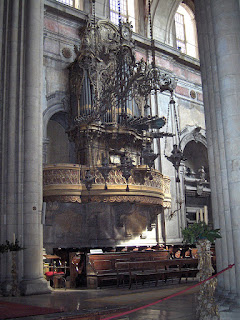Netherlands issued a set of two stamps in 2014, the European Year for musical instruments. The stamps celebrate the Drei Pruiken Draaiorgal, a famous street organ in that country. The instrument is characterized by three be-wigged statues as part of the decoration.
Information about the organ from Hans Timmermann's
site:
De firma werd in 1875 opgericht door Orgelbouwer Leon Warnis uit België Oorspronkelijk verhuurde de firma alleen maar draaiorgels, later kwamen daar ook reparaties en nieuwbouw bij. In 1932 nam de familie Perlee de onderneming over en begon een orgelmakers werkplaats in de Westerstraat 119 in Amsterdam, waar deze zich nu nog bevindt.
Het draaiorgel de "Drie Pruiken" werd in 1953 uit de resten van een oud Gavioli-Orgel gebouwd.
Het was de eerste nieuwbouw van de firma na de 2e wereldoorlog. De naam is ontleend aan de drie figuren op de voorzijde die historische kostuums en grote pruiken dragen. De drie pruiken is nog volledig intact. Er wordt zelfs geregeld nieuwe muziek speciaal voor dit bekende orgel gecomponeerd. De drie pruiken is eigendom van Museum Speelklok in Utrecht. Dit museum beheert de grootste collectie straatorgels uit de twintigste eeuw.
The company was founded in 1875 by Orgelbouwer Leon Warnis from Belgium Originally, the company rented only spin organizers, later arrived there including repairs and new construction. In 1932, the Perlee family took over the company and began one- organ workmaker's workshop in the Westerstraat 119 in Amsterdam, where it is still located.
The rotary organ "Drie Wruiken" was built in 1953 from the remains of an old Gavioli organ.
It was the company's first new building after the 2nd World War. The name is derived from the three figures on the front which carry historical costumes and big wigs. The three wigs are still completely intact. Even new music is specially composed for this well-known organ. The three wigs are owned by Museum Speelklok in Utrecht. This museum manages the largest collection of street organizers of the twentieth century.















